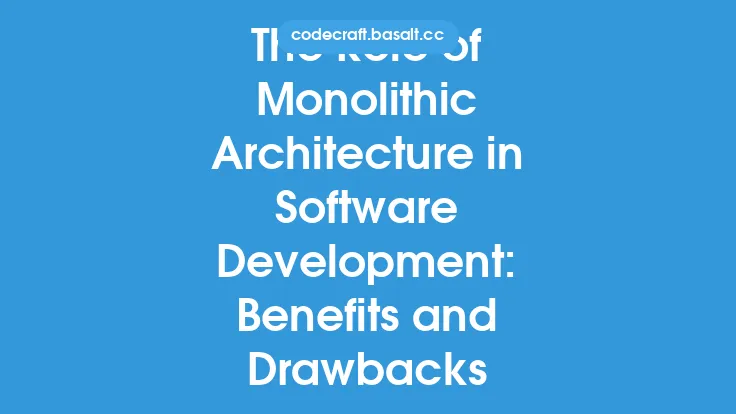The concept of monolithic architecture has been around for decades, and its evolution is a testament to the changing needs and technologies in the software development landscape. Traditionally, monolithic architecture referred to a self-contained, tightly coupled system where all components were interconnected and interdependent. This approach was widely used in the early days of software development, where systems were relatively simple and didn't require the scalability and flexibility that modern systems demand.
History of Monolithic Architecture
The history of monolithic architecture dates back to the 1960s, when the first commercial computer systems were developed. These early systems were designed to perform specific tasks, such as payroll processing or inventory management, and were typically built using a single programming language and a limited number of components. As software development evolved, so did the complexity of monolithic systems. The 1980s saw the introduction of relational databases, which enabled the development of more sophisticated monolithic systems that could handle large amounts of data. The 1990s brought the rise of object-oriented programming (OOP) languages, such as Java and C++, which further increased the complexity and scalability of monolithic systems.
Traditional Monolithic Architecture
Traditional monolithic architecture is characterized by a single, self-contained unit that encompasses all the components and functionality of the system. This approach is often referred to as a "big ball of mud" due to its tightly coupled and interconnected nature. In a traditional monolithic system, all components are designed to work together seamlessly, with each component depending on others to function correctly. This approach can lead to a number of issues, including tight coupling, low cohesion, and a high degree of complexity. Traditional monolithic systems are often difficult to maintain, scale, and evolve, as changes to one component can have a ripple effect throughout the entire system.
Modern Approaches to Monolithic Architecture
In recent years, there has been a shift towards more modern approaches to monolithic architecture. These approaches aim to address the limitations and challenges of traditional monolithic systems by introducing new design principles, patterns, and technologies. One such approach is the use of domain-driven design (DDD), which emphasizes the importance of understanding the core business domain and modeling the system around it. DDD encourages the use of bounded contexts, which are smaller, more focused domains that can be developed and maintained independently. Another approach is the use of microkernel architecture, which separates the core functionality of the system from the surrounding components and services. This approach enables greater flexibility and scalability, as new components and services can be added or removed without affecting the core system.
Technological Advancements
Technological advancements have played a significant role in the evolution of monolithic architecture. The rise of cloud computing, containerization, and orchestration has enabled the development of more scalable and flexible monolithic systems. Cloud computing provides on-demand access to computing resources, allowing monolithic systems to scale up or down as needed. Containerization, using technologies such as Docker, enables the packaging of monolithic systems into smaller, more manageable components that can be easily deployed and managed. Orchestration tools, such as Kubernetes, provide a way to manage and coordinate the deployment of monolithic systems, ensuring that they are properly configured and scaled.
Design Principles and Patterns
Modern monolithic architecture is guided by a set of design principles and patterns that aim to address the limitations of traditional monolithic systems. One such principle is the separation of concerns (SoC), which encourages the separation of different components and functionality into distinct modules or layers. Another principle is the use of interfaces and abstraction, which enables loose coupling and high cohesion between components. Design patterns, such as the model-view-controller (MVC) pattern, provide a way to structure monolithic systems in a logical and maintainable way. The MVC pattern separates the system into three interconnected components: the model, which represents the data and business logic; the view, which represents the user interface; and the controller, which manages the interaction between the model and view.
Challenges and Limitations
Despite the advancements in monolithic architecture, there are still challenges and limitations to be addressed. One of the main challenges is the issue of tight coupling, which can make it difficult to maintain and evolve monolithic systems. Another challenge is the lack of scalability, which can limit the ability of monolithic systems to handle large amounts of traffic or data. Additionally, monolithic systems can be difficult to test and debug, due to their complex and interconnected nature. To address these challenges, developers must carefully consider the design principles and patterns used in monolithic architecture, as well as the technological advancements that can enable greater scalability and flexibility.
Conclusion
The evolution of monolithic architecture is a testament to the changing needs and technologies in the software development landscape. From traditional to modern approaches, monolithic architecture has come a long way, incorporating new design principles, patterns, and technologies to address the limitations and challenges of traditional monolithic systems. While there are still challenges and limitations to be addressed, the use of modern approaches to monolithic architecture can enable the development of more scalable, flexible, and maintainable systems that meet the needs of modern software development. By understanding the history, principles, and patterns of monolithic architecture, developers can create systems that are better equipped to handle the demands of today's software landscape.





